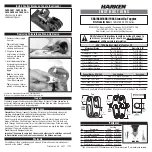
TruSat Technical Reference Manual
1–4
1.3 Safety precautions
Precautions associated with following safe practices while using the monitor appear
throughout this manual. General precautions are listed below. Carefully read all
precautions in this manual before repairing or using the monitor.
NOTE: For complete information about the safe and appropriate use of a sensor,
consult the instructions for that sensor.
Warnings
WARNINGS indicate potentially harmful situations that may cause injury to
a patient or operator.
•
Do not use the monitor if the startup tones do not sound, the validity of data is
questionable, or if the monitor fails to function as described. Refer to the
appropriate sections of this manual to identify and correct the malfunction.
•
Do not use the monitor in the presence of any flammable anesthetic mixture.
•
Use only hospital-grade, grounded power outlets.
•
Use only sensors and cables specified for use with this monitor.
Failure to do so
may cause interference with the measurement or result in increased emissions,
decreased immunity, or damage to the equipment or system.
•
This monitor is not intended for use in a magnetic resonance imaging (MRI)
en vironment.
•
When you connect equipment to the monitor, you are configuring a medical
system and are responsible for ensuring that the system complies with
IEC 60601–1–1 and with local requirements. Connect only external devices
specified for use with this monitor.
•
Power OFF and disconnect the monitor from external power before performing
any procedure that involves disassembly of the monitor.
Cautions
CAUTIONS
indicate conditions that may lead to equipment damage or
malfunction.
•
Internal electronic components are susceptible to damage by electrostatic
discharge. To avoid damage when disassembling the monitor, observe the
standard precautions and procedures for handling static-sensitive components.
•
Do not store or use the monitor outside the temperature and humidity ranges
stated in the
Specifications
section of this manual.
•
Never use a battery if its insulative wrap is ripped, torn, or has other visible
damage. A damaged battery wrap can cause internal shorting, overheating, or
other equipment damage.
Disposal
Recycle or dispose of this medical device, its components, and its packing materials
in accordance with local environmental and waste disposal regulations.











































